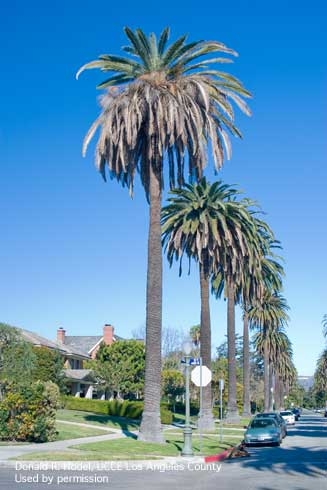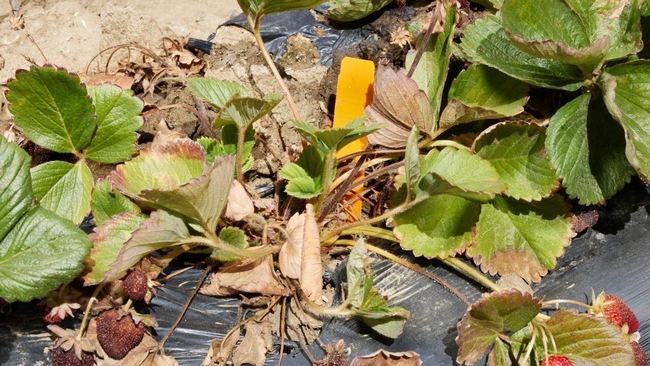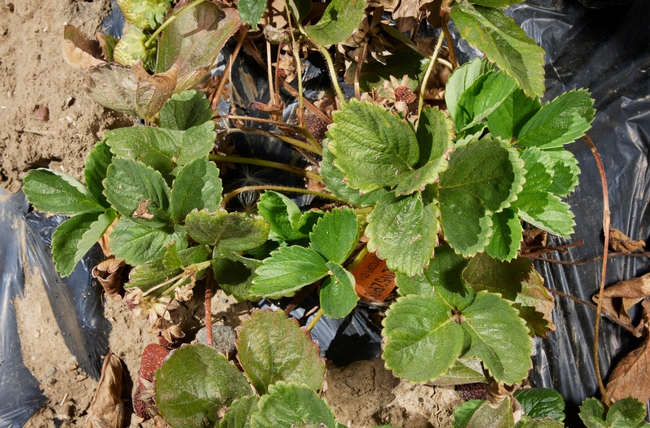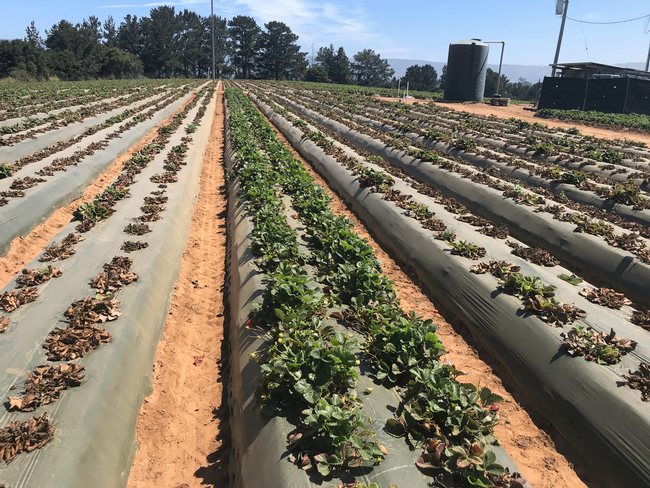
Posts Tagged: wilt
Researchers identify genes making strawberries resistant to Fusarium wilt
Resistant varieties to be released later this year to growers
Strawberry losses from Fusarium wilt could become less of a threat after researchers at the University of California, Davis, discovered genes that are resistant to the deadly soilborne disease.
The findings, published in the journal Theoretical and Applied Genetics, are the culmination of several years' work, and the discovery will help protect against disease losses, said Steve Knapp, director of the Strawberry Breeding Program at the college.
“What we've accomplished here is important and it's valuable for the industry and it's going to protect growers,” Knapp said.
Strawberries are a key crop in California, where about 1.8 billion pounds of the nutritious fruit are grown each year, making up roughly 88% of what is harvested in the United States.
Finding the genes could prevent a Fusarium wilt pandemic.
“The disease has started to appear more often up and down the state,” said Glenn Cole, a breeder and field manager with the Strawberry Breeding Program. “Once the wilt gets in, the plant just crashes. You have total die out.”
Searching for resistance
UC Davis scientists screened thousands of strawberry plants in the college nursery and took DNA samples. They then used genetic screening and developed DNA diagnostics to identify genes that are resistant to the primary race of Fusarium wilt.
“The genes have been floating around in the strawberry germplasm for thousands of years,” Cole said, but no one worked to identify them.
This latest development brings “strawberry into the 21st century in terms of solving this problem,” Knapp said.
Protecting future crops
This work means breeders can introduce the resistant gene into future strawberry varieties. This fall the program will release new cultivars that have the Fusarium wilt resistance gene. And the DNA diagnostic tools will help breeders respond to new Fusarium wilt variants that develop.
“There will be new threats and we want to be prepared for them,” Knapp said. “We want to understand how this works in strawberries so that as new threats emerge, we can address them as rapidly as possible.”
“If you don't have fusarium resistance, you're done,” Cole said. “The disease could be around more than you think.”
Fusarium wilt hasn't traditionally been an issue but when the fumigant methyl bromide was phased out in 2005, things changed. The disease was in the soil and without the fumigant, instances of wilt increased, especially in areas where crops weren't rotated.
Breeding new varieties
Knapp and Cole have informed the industry about current strawberry varieties that have the resistance so they can select plants with that added protection. The new resistant varieties coming out later this year will be suitable for several growing seasons.
“It's a big deal,” Cole said. “Everything is incremental in plant breeding, but it's a big deal.”
Plant scientists have been breeding strawberries at UC Davis since the 1930s and they have released more than 60 patented varieties through the public breeding program.
All of the work happened at UC Davis. Dominique Pincot, Mitchell Feldmann, Mishi Vachev, Marta Bjornson, Alan Rodriguez, Randi Famula and Gitta Coaker from the Department of Plant Sciences, and Thomas Gordon from the Department of Plant Pathology contributed to the research, as did Michael Hardigan and Peter Henry who are now at the U.S. Department of Agriculture Agricultural Research Service and Nicholas Cobo who is at University of La Frontera in Chile.
The research was funded by UC Davis and grants from the USDA National Institute of Food and Agriculture Specialty Crop Research Initiative.
Keep Your Palm Trees Disease-free
Palm trees are commonly seen in California, making some think about the tree-lined streets of...

D-WO-FOXY-FO.010
Spiny buttercup: A toxic weed and host for tomato spotted wilt virus
Spiny buttercup (Ranunculus muricatus) is a non-native plant, that is fairly common, especially...
Targeting Thrips
If you grow tomatoes, you ought to be concerned about thrips. They're pests of fruits,...

George Kennedy, the William Neal Reynolds Distinguished Professor of Agriculture at North Carolina State University, stopped to count thrips during a vacation to Mt. St. Helens. (Photo by Scott Kennedy)
Verticillium wilt and Compost Amendments
Verticillium dahliae is the cause of Verticillium wilt, a disease that affects strawberries and many other plant species, including annual vegetables, fruit trees, nut trees and fiber crops, as well as weeds and native plants in California. Once a susceptible plant is infected, V. dahliae can produce large numbers of survival structures (called microsclerotia) (Vallad and Subbarao, 2008), which can survive in the soil for more than 14 years (Wilhelm, 1955). In addition, V. dahliae can colonize the roots of many crops that are not susceptible to disease and may show no symptoms (Lloyd and Gordon, 2011). This provides another means by which the fungus can produce survival structures. Verticillium dahliae is easily spread between fields with soil on farming equipment. It can also be introduced with seed (Wu and Subbarao, 2014) or infected transplants. Owing to the ease of dispersal, a wide host range and production of long-lived survival structures, V. dahliae is resident in agricultural soils throughout the state. Whether or not Verticillium wilt occurs in a particular situation is determined by the susceptibility of the crop variety being grown and the abundance of inoculum in soil. Consequently, the absence of disease does not mean the pathogen is not present. In fact, it is likely that V. dahliae occurs at some level in most fields in coastal California. Good management practices aim to keep the inoculum level below a damaging threshold (Gordon and Subbarao, 2007).
Many growers use compost amendments to improve the physical and chemical properties of soil. Compost can also enhance the activity of microorganisms that are inhibitory to plant pathogenic fungi (Mazzola, 2004). However, compost made from crop residue may include plants that were infected with V. dahliae, and because microsclerotia can survive in animal guts (Markakis, 2014), manure may be contaminated as well. Proper composting is required to ensure that no viable microsclerotia remain in the final product. The California Composting Council and CalRecycle have established regulations that require materials reach 55 °C (131°F) or higher for 15 days or longer with a minimum of five turnings of the windrow during this time (Cal Recycle, Title 14, Chapter 3.1), which should be sufficient to kill V. dahliae microsclerotia in manure or crop residue (Baker, 1957). All state permitted composting facilities are visited monthly by the local enforcement authority (LEA) to ensure compliance with these regulations. Consequently, if your supplier is operating under a state permit, the compost you purchase is unlikely to be a source of inoculum of V. dahliae, and it would not be advisable to forego the benefits of compost amendments out of concern that this will increase the risk of damage from Verticillium wilt.
REFERENCES
Cal Recycle. Title 14, Chapter 3.1. Composting Operations Regulatory Requirements, Article 5. Composting Operation and Facility Siting and Design Standards, Section 17868. 3. Pathogen Reduction. http://www.calrecycle.ca.gov/Laws/Regulations/title14/ch31a5.htm
Baker, KF and Roistacher, CN. 1957. Heat treatment of soil. In K.F. Baker [ed]. The U.C. system for producing healthy container-grown plants. Calif. Agr. Exp. Sta. Manual 23:123-137.
Gordon, TR and Subbarao, KV. 2007. Production Guidelines: Verticillium wilt of Strawberry. California Strawberry Commission, Issue 1: 1-4.
Lloyd, M and Gordon, TR. 2011. Evaluation of ten leguminous cover crops as cryptic hosts for Verticillium dahliae. Phytopathology 101: S109-S109.
Markakis, EA. et al. 2014. Survival, persistence and infection efficiency of Verticillium dahliae passed through the digestive system of sheep.Plant Disease, (ja).
Mazzola, M. 2004. Assessment and management of soil microbial community structure for disease suppression. Annual Review of Phytopathology 42: 35-59.
Vallad, GE and Subbarao, KV. 2008. Colonization of resistant and susceptible lettuce cultivars by a green fluorescent protein-tagged isolate of Verticillium dahliae. Phytopathology 98:871-885.
Wilhelm, S. 1955. Longevity of the Verticillium wilt fungus in the laboratory and field. Phytopathology 45:180-181.
Wu, B and Subbarao, KV. 2014. A model for multi-seasonal spread of Verticillium wilt of lettuce. Phytopathology 104:908-917.

Windrows of compost. Photo courtesy Margaret Lloyd, UC Davis



